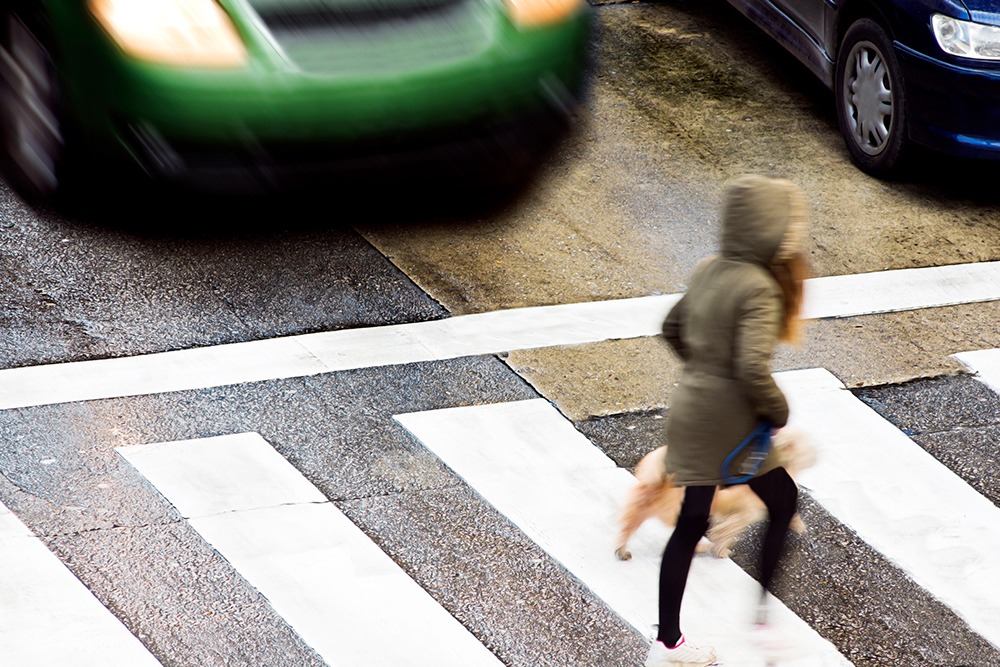How to Avoid Becoming a Pedestrian Accident Statistic
Share:
Walking is something we all do without thinking about it—heading to the office, walking the dog, or enjoying an evening jog. But despite its simplicity, walking can be surprisingly dangerous when cars and people share the same space.
In fact, the National Highway Traffic Safety Administration (NHTSA) reports that more than 7,500 pedestrians were killed in the U.S. in 2022—the highest number in over 40 years. That doesn’t include the hundreds of thousands who were injured, many left facing broken bones, traumatic brain injuries, and long recoveries.
The good news? Many of these tragedies are preventable. By understanding the most common causes of pedestrian accidents and learning how to avoid them, both drivers and walkers can reduce risks and save lives
Cause #1: Distracted Driving
The issue: Phones, GPS systems, food, and even adjusting the radio can take a driver’s attention off the road. And it only takes a moment of distraction for disaster to strike—especially if a pedestrian steps into a crosswalk.
The impact: Distracted driving leads to thousands of fatalities each year. Pedestrians are particularly at risk because they lack the protection of a vehicle.
Real-world example: A driver glances at a text for three seconds—long enough for their car to travel the length of a football field at highway speed. In that instant, they miss the pedestrian walking with the light.
Prevention tips:
- Drivers: Turn your phone on “Do Not Disturb” mode while driving. Set GPS directions before leaving.
- Pedestrians: Stay alert too—avoid wearing headphones at high volume or scrolling your phone while crossing streets.
Cause #2: Failure to Yield
The issue: Many pedestrian accidents happen when drivers fail to yield at crosswalks or intersections. Drivers making left-hand or right-on-red turns often focus only on oncoming vehicles, overlooking pedestrians.
The impact: According to the Insurance Institute for Highway Safety (IIHS), nearly 1 in 5 pedestrian deaths happens at intersections, often due to drivers failing to yield.
Real-world example: A driver in a rush to beat traffic ignores the pedestrian signal. The pedestrian, who had the legal right-of-way, is struck while crossing.
Prevention tips:
- Drivers: Slow down at intersections. Always check for pedestrians before turning.
- Pedestrians: Wait until cars come to a complete stop before stepping into a crosswalk—even if you have the walk signal.
Cause #3: Poor Visibility
The issue: Darkness, bad weather, and poorly designed roads make it harder for drivers to spot pedestrians. Notably, 75% of pedestrian fatalities occur at night.
The impact: Pedestrians walking along unlit roadways or crossing mid-block in dim conditions are at much higher risk of being struck.
Real-world example: A pedestrian wearing dark clothing crosses a poorly lit street after dusk. A driver, already dealing with glare from headlights, doesn’t see them until it’s too late.
Prevention tips:
- Drivers: Reduce speed at night and in bad weather. Use high beams when appropriate.
- Pedestrians: Wear reflective or light-colored clothing. Carry a flashlight or use your phone’s light when walking after dark. Stick to well-lit areas whenever possible.
Cause #4: Impaired Driving—and Impaired Walking
The issue: Alcohol and drugs slow reaction times and impair judgment for both drivers and pedestrians.
The impact: The NHTSA reports that nearly half of pedestrian fatalities involve alcohol use—either by the driver, the pedestrian, or both. Impaired drivers are less likely to notice pedestrians, while impaired pedestrians may take risks like jaywalking or crossing against the light.
Real-world example: A driver leaving a bar underestimates their impairment, fails to notice a pedestrian in the crosswalk, and tragedy follows.
Prevention tips:
- Drivers: Never drive impaired—designate a driver, call a rideshare, or use public transportation.
- Pedestrians: If you’ve been drinking, stick to sidewalks, use crosswalks, and avoid high-traffic roads. Ask a sober friend to accompany you if possible.
Cause #5: Unsafe Road Design and Infrastructure
The issue: Not all streets are created equal. Missing sidewalks, poorly timed signals, faded crosswalks, and high-speed roads make walking dangerous.
The impact: Communities with pedestrian-friendly designs—like raised medians, countdown signals, and speed-calming measures—see fewer accidents. Conversely, poorly designed streets force pedestrians into unsafe situations.
Real-world example: A neighborhood without sidewalks forces pedestrians to walk on the shoulder of a busy road, dramatically increasing the risk of being struck.
Prevention tips:
- Drivers: Slow down in pedestrian-heavy areas like schools, neighborhoods, and downtown districts.
- Pedestrians: Use marked crosswalks when available. Support community efforts to advocate for safer road designs.
What to Do If You’re Involved in a Pedestrian Accident
Even when everyone takes precautions, accidents still happen. If you’re hit by a car—or a loved one is—here’s what to do immediately:
- Get medical attention immediately. Even “minor” injuries can hide serious internal damage.
- Call the police. An official report will document the incident and help your case later.
- Gather evidence. Take photos of the scene, your injuries, and the vehicle. Get names of witnesses.
- Avoid early settlement offers. Insurance companies may push quick, low payouts. Don’t accept without advice.
- Contact a pedestrian accident attorney. An experienced lawyer can protect your rights, investigate the accident, and fight for full compensation.
Victims may be entitled to damages for medical bills, rehabilitation, lost income, pain and suffering, and more.
Final Thoughts
Pedestrian accidents aren’t just “bad luck”—they have identifiable causes, and many are entirely preventable. By addressing the biggest risks—distracted driving, failure to yield, poor visibility, impairment, and unsafe road design—we can reduce the staggering toll on pedestrians.
At DuFault Law, we fight for pedestrians across Florida and Georgia who’ve been injured by careless drivers or unsafe road conditions. If you or a loved one has been hit while walking, you don’t have to take on the insurance companies alone. We’ll fight to secure justice and the compensation you deserve.
Injured in a Pedestrian Accident? Protect Your Rights Today.
Pedestrian accidents can change lives in an instant, leaving victims facing serious injuries, medical bills, and lost income. If you or a loved one has been struck by a car, don’t let insurance companies minimize your claim.
At DuFault Law, our experienced pedestrian accident attorneys fight for victims across Florida and Georgia. We’ll investigate your case, hold negligent drivers accountable, and pursue the compensation you need to move forward.



Comments are closed